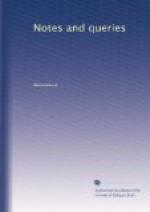Runes.—Worsaeae (Primeval Antiquities of Denmark, 1849) mentions that inscriptions are found in Denmark, Norway, and Sweden, written in different languages in Runic character. He also mentions the fact of a Pagan Runic inscription occurring at Jellinge, Denmark, on the tomb of old King Gorm, A.D. c. 900, found in a huge barrow; and, at the same place, a Christian Runic inscription on the tomb of his son Harold. Has this inquiry been extended to British Runes, and might it not throw much light upon many monuments of dates prior to the Conquest? Crossed slabs with Runes have been found at Hartlepool, Durham; have the inscriptions been read? (Boutell’s Christian Monuments, p. 3.; Cutt’s Manual of Sepulchral Slabs, pp. 52. 60. plate III.)
* * * * *
MISCELLANEOUS.
NOTES ON BOOKS, CATALOGUES, SALES, ETC.
The Nibelungenlied, which has been aptly designated the German Iliad, has hitherto been a sealed book to the mere English reader. Mr. Lettsom has however just published a most successful translation of it under the title of The Fall of the Nibelungers. Few will rise from a perusal of the English version of this great national epic—which in its present form is a work of the thirteenth century—without being struck with the innate power and character of the original poem; and without feeling grateful to Mr. Lettsom for furnishing them with so pleasing and spirited a version of it.
Captain Curling, Clerk of the Cheque of what was formerly designated the Band of Gentleman Pensioners, has, under the influence of a laudable esprit de corps, combined the disjointed materials which Pegge had collected upon the subject with the fruits of his own researches; and, under the title of Some Account of the Ancient Corp of Gentlemen-at-Arms, has produced a volume of great interest doubtless to his “brothers in arms,” and containing some curious illustrations of court ceremonial.[9]
Mr. Timbs, the editor of The Year-Book of Facts, &c., announces for early publication a work on which he has been engaged for some time, entitled Curiosities of London. It will, we believe, be altogether of a different character from Mr. Cunningham’s Handbook, and treat rather of present London and its amusements than those of historical and literary associations which give a charm to Mr. Cunningham’s volume.
We are glad to find that the most mysterious and mystified portion of the Greek Geometry is likely to receive at last a complete elucidation—we mean the “Porisms.” There are so many questions arising out of this subject, respecting the development of the Grecian intellect, that a full discussion of them is no easy task; especially of those arising out of the conflicting testimonies furnished by history, and by the internal evidences contained in the existing




